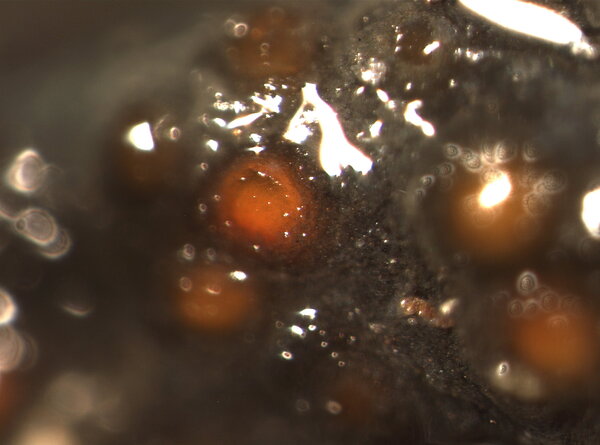Lempholemma elveloideum (Ach.) Zahlbr.
Cat. Lich. Univ., 3: 21, 1924. Basionym: Collema elveloideum Ach. - Lichenogr. Univ.: 641, 1810.
Synonyms: Arnoldia cyathodes A. Massal.; Collema cyathodes (A. Massal.) Nyl.; Physma cyathodes (A. Massal.) Jatta; Plectopsora cyathodes (A. Massal.) A. Massal.; Plectopsora elveloidea (Ach.) Zanfr.
Distribution: N - Ven (Lazzarin 2000), Lomb (S- F145122), Piem (Isocrono & al. 2004). C - Tosc.
Description: Thallus squamulose to subfoliose, 3-8(-10) mm wide, umbilicate-monophyllous, firmly attached, homoiomerous, gelatinous when wet, black, sometimes grey-pruinose in central part, with a central depression and down-turned margins, attached by a central holdfast. Apothecia rather rare, laminal, immersed, with an initially pore-like, then slightly expanded and urceolate, brown disc. Proper exciple very thin, of parallel hyphae; epithecium brownish; hymenium and hypothecium colourless, the hymenial gel I+ reddish, K/I+ blue; paraphyses mostly simple, coherent, not apically thickened; hypothecium colourless. Asci 8-spored, prototunicate, cylindrical, without a distinct apical apparatus. Ascospores 1-celled, hyaline, narrowly ellipsoid to fusiform, 15-27 x 7-10 μm. Photobiont cyanobacterial (Nostoc, the cells in chains). Spot tests: all negative. Chemistry: without lichen substances. Note: a mainly temperate lichen found on steeply inclined faces of calcareous rocks, in seepage tracks, often with other cyanobacterial lichens, certainly much overlooked throughout Italy.
Growth form: Foliose, umbilicate
Substrata: rocks
Photobiont: cyanobacteria, filamentous (e.g. Nostoc, Scytonema)
Reproductive strategy: mainly sexual
On otherwise dry surfaces with short periods of water seepage after rain
Commonnes-rarity: (info)
Alpine belt: absent
Subalpine belt: absent
Oromediterranean belt: absent
Montane belt: extremely rare
Submediterranean belt: very rare
Padanian area: absent
Humid submediterranean belt: rare
Humid mediterranean belt: rare
Dry mediterranean belt: absent

Predictive model
Herbarium samples
Growth form: Foliose, umbilicate
Substrata: rocks
Photobiont: cyanobacteria, filamentous (e.g. Nostoc, Scytonema)
Reproductive strategy: mainly sexual
On otherwise dry surfaces with short periods of water seepage after rain
Commonnes-rarity: (info)
Alpine belt: absent
Subalpine belt: absent
Oromediterranean belt: absent
Montane belt: extremely rare
Submediterranean belt: very rare
Padanian area: absent
Humid submediterranean belt: rare
Humid mediterranean belt: rare
Dry mediterranean belt: absent

Predictive model
| Herbarium samples |
 Index Fungorum
Index Fungorum
 GBIF
GBIF













